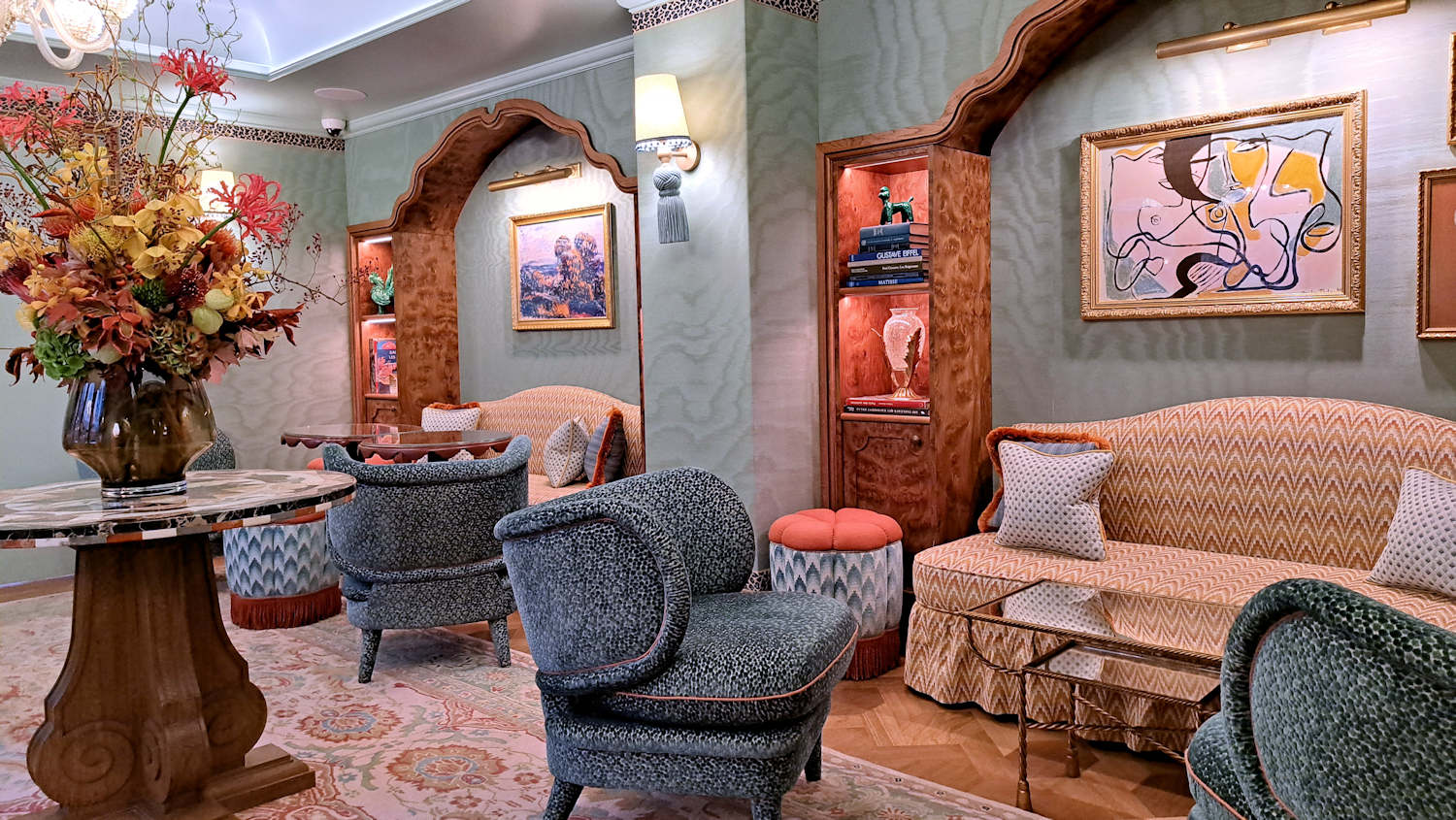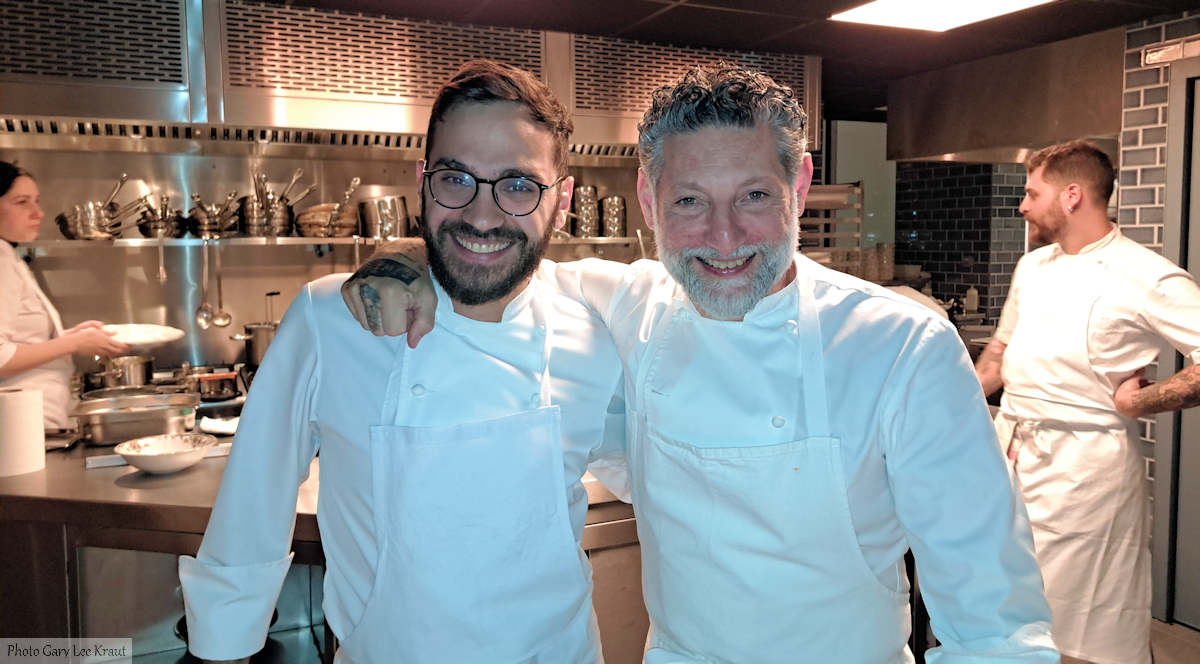
Lobby of Le Grand Mazarin. Photo GLKraut.
“We wanted the hotel to feel like it has always been a part of the Marais landscape,” Swedish, London-based interior designer Martin Brudnizki is quoted on the website of the new Paris 5-star hotel Le Grand Mazarin as saying. “… We were therefore inspired by the great Houses of the aristocratic era.”
He is referring there to the mansions and townhouses built in the 17th century when the Marais became trendy territory for the construction of noble residences and their continued use and decorative evolution by the titled and entitled through most of the 18th century. The Revolution then sent the aristocratic owners and renters either into exile or to the guillotine, after which “always been a part of the Marais landscape” came to mean something vastly different.
No longer marked by great wealth and privilege, the Marais was increasingly defined by labor, light industry, immigration and poverty. There were still dozens of grand old mansions around, but by 1900, the Marais swelled with a poor and working-class population, including many immigrants, among them thousands of Jews from Yiddish-speaking communities in Eastern Europe, with many more arriving through the 1930s. The Holocaust then sent the Jewish population either fleeing or to the death camps, leaving behind a decrepit cityscape that the rare visitor in the 1940s, 1950s, 1960s, even 1970s may well have thought had “always been a part of the Marais.”
The 311-acre heart of the Marais was saved from further ruin and the specter of concrete-and-glass renewal by a national law of 1962 calling for district-wide historic preservation and restoration. The law, along with the subsidies, public works and business opportunities that would eventually follow, accompanied the continuing evolution of the Marais, with: the arrival of Sephardic Jews to Paris in the 1950s and 1960s; the opening of the Picasso Museum in 1985; the opening of gay bars and clubs in the latter half of that decade; the steep rise in real estate prices in the 1990s; the development through the 2000s of rue des Rosiers, formerly part of the Pletzl at the epicenter of pre-war Yiddish-speaking immigration in the Marais, into a street that’s part Jewish food court part internationally-branded boutiques, and, in the 2010s, the listing of a considerable number of properties on Airbnb, each promising “charm” and “exposed wooden beams” (read: old buildings now gentrified).
Slowly at first, then much quicker since the mid-1980s, the Marais evolved into such a well-maintained on-the-radar quarter for strolling, shopping, museum-going, art-gallery-contemplating, café-sitting, with a few gay bars here, and a few Jewish restaurants there, that today’s visitor might think that its trendy bourgeois-casual lifestyle and the ease of communicating in English “have always been a part of the Marais landscape.”
Le Grand Mazarin
Where, then, do Le Grand Mazarin and its restaurant Boubalé fit into today’s Marais?
On the edge, or in many ways as its main entrance, catercorner to City Hall, in a 19th-century building across the street from the BHV Marais department store, at one corner of Place Harvey Milk, named for assassinated American defender of gay rights. A doorman in pride purple livery stands by the hotel entrance.
Past the small reception area, the drawing-room lobby presents a muted flamboyance, introducing visitors to the muted greens, reds and blues that dominate throughout the building and to the cozy, quirky, sophisticated nostalgia that impregnates the place.
The 50 rooms and 11 suites present a potpourri of furnishings, each outlined with a prominent curve or bevel, with enough reminders of 18th-century styles that the pre-Revolutionary petite noblesse would feel very much at ease here. It’s design without being high design, welcoming without being precious, indulgent without being lavish. Above all, it’s stylishly comfortable. The rooms are of modest size, as one would expect in the Marais. Rates start at 590€ and will rise beginning spring 2024.
The hotel’s restaurant Boubalé, described below, serves traditional Askenazic/Israeli fare. There’s also has a little, kitsch-chic, ground-floor bar. In the basement there’s an attractive pool with a fresco reminiscent of Cocteau’s work along its arched ceiling. A VIP basement lounge-bar will also soon open in another portion of the basement.
All told, the upmarket hotel, restaurant, bar and VIP room that form Le Grand Mazarin don’t seem to have “always been a part of the Marais landscape” so much as they present a cheery, nostalgic pastiche of major markers of the Marais of the past five centuries.

Boubalé
This restaurant and its adjacent bar are very much part and parcel of Le Grand Mazarin but with separate entrances from the hotel. So they can certainly be considered for anyone not lodging upstairs.
While the hotel’s rooms and suites call to mind the well-being of the petite noblesse, Boubalé—the restaurant’s name is a Yiddish term of endearment—and the bar appear to have been inspired by a vigorous and stylish older actress in Yiddish theater who enjoys hanging out with the younger crowd.
As noted above, the restaurant serves traditional Ashkenazic/Israeli cuisine. Jerusalem-born chef Assaf Granit has become a prime purveyor of Israeli cuisine in France. He’s the first Israeli chef to have a Michelin star in France (at Shabour in the Paris’s 2nd arrondissement). As executive chef with the JLM Group, he has been overseeing Boubalé in its opening period before the restaurant’s executive chef Itmar Gargei takes full command of the kitchen.
“Tradition, tradition!… Tradition!”—you know the song. This is the menu version of that: challah, pastrami plate, gravlax, roast beets with feta and horseradish, chopped chicken liver… seafood knaidlach, “ashkenazi mesachen,” “goulash+gnochhis”… strudel, babka… More polished than revisited, it’s all tasty—“entertaining” is perhaps a more accurate word—in a traditional smorgasbord kind of way. If not made with Bubbie love, then at least made with open-kitchen care. Ordering several appetizers (we ordered nearly all of them) to share is the way to go, both to get a taste of the various dishes and to get into the upbeat spirit of the place. The aforementioned Yiddish actress may well have had the tableware custom-made in the old country; her children will let it gather dust in the closet when they inherit it, but the grandkids and their kids will find it delightful. Anyway, Boubalé isn’t meant for her own children, now too old for this. On the two evening that I dined here (once as a guest*, once as a host), the majority of the crowd appeared to be under 35. There’s a good, upbeat vibe if you don’t mind the rising music and voice level as the evening progresses.
A 3-course meal, with challah (10€), will run about 75€, without drinks. I leave it to you to decide if that’s “oy vey” pricing.

The Bar
As someone who enjoys the atmosphere of hotel bars, I found the playful kitsch-chic décor of the little ground-floor bar quite to my liking as a place to wind down the evening. Here, I had my first taste of the Tunisian fig brandy Boukha, a drink with an Ashkenazic-Sephardic history of its own. The basement club/bar, is intended as a no-cell phone space to wind up the night, wasn’t yet open when I visited.
Le Grand Mazarin and the restaurant Boubalé, 17 rue de la Verrerie, Paris 4th arrondissement.
Le Grand Mazarin is the latest of the Pariente family’s slowly growing collection of distinctive 5-star hotels under the umbrella name Maisons Pariente, including Crillon Le Brave in Provence, Le Coucou in Méribel and Lou Pinet in Saint Tropez.
* Disclaimer: As many readers know, I wear various professional hats: travel writer and editor of this publication, travel and tour advisor for agencies and individuals, and organizer/guide in Paris and throughout France. I have worn all three with respect to Le Grand Mazarin: 1. In writing this article. 2. In first dining here as a guest on a site visit with a luxury travel agency, then second dining here on a tasting tour that I organized and hosted for visitors to Paris. 3. Subsequent to that first visit I was hired by the hotel to give a tour of the Marais to visiting journalists.
© 2023, Gary Lee Kraut

